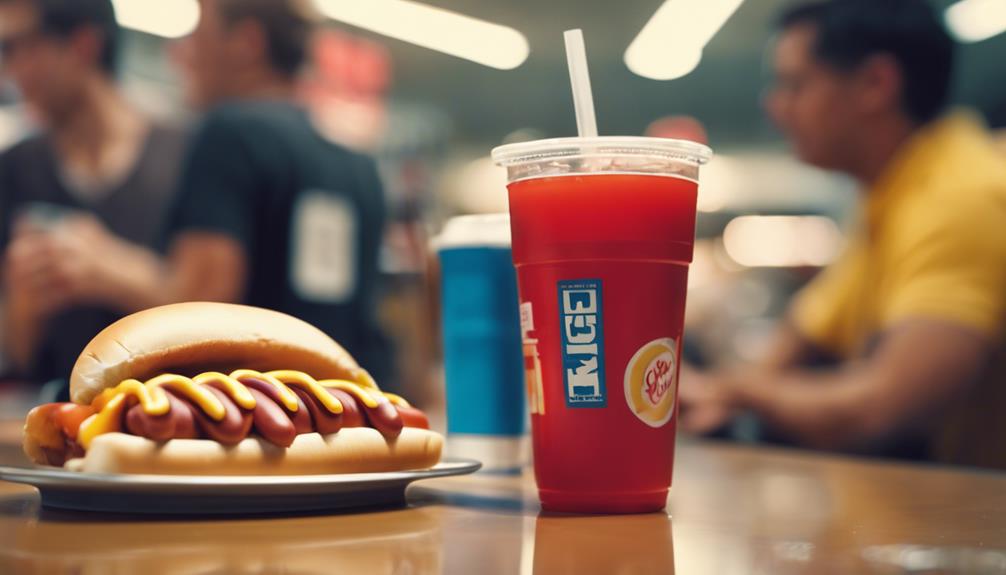Tennis fans are feeling the pinch as drink prices soar at the US Open, with the popular Honey Deuce now costing a hefty $22. This signature cocktail, a fan-favorite made with Grey Goose vodka, has seen its price steadily rise, leaving many attendees shocked and disappointed. Social media buzz reflects their frustration, with comparisons to the cost of an entire bottle of vodka. Rising ticket prices and expensive hotel accommodations only add to the burden. Fans are beginning to question whether the experience still offers good value. More insights on fan reactions and the rising costs await.
Key Takeaways
- The price of the signature drink, Honey Deuce, has increased to $22, causing shock among fans.
- Fans are expressing disappointment on social media, comparing the drink's price to an entire bottle of vodka.
- Concession prices have risen by about 10%, adding to the financial burden for attendees.
- Rising costs, including drinks and tickets, are leading fans to reconsider their spending at the event.
Impact of Inflation on Prices
Inflation is substantially driving up prices at the US Open, impacting everything from ticket costs to concession items.
Fans are feeling the pinch as ticket prices soar, with the cheapest seats for the Women's finals starting at $180. Men's and Women's Doubles Final tickets are even pricier, beginning at $350 on Stubhub.
Concession prices have risen by about 10%, putting a strain on attendees' budgets. The signature drink, the Honey Deuce, now costs $22, up from $20 just a few years ago.
Local hotels are also capitalizing on the event, charging upwards of $519 per night during the tournament's early rounds.
As costs rise, fans are forced to reconsider their spending while trying to enjoy the iconic event.
The Popularity of the Honey Deuce

The Honey Deuce has become a fan-favorite at the US Open, drawing attention not just for its unique flavor but also for its iconic status among tournament beverages. This Grey Goose vodka-based cocktail, made with raspberry liqueur and lemonade, garnished with honeydew melon shaped like tennis balls, captures the spirit of the event. Since its debut in 2007, over 1 million Honey Deuces have been sold, showcasing its popularity.
| Year | Price | Sales |
|---|---|---|
| 2007 | $18 | N/A |
| 2019 | $20 | 250,000 |
| 2023 | $22 | N/A |
Despite rising costs, fans continue to indulge in this signature drink, making it a staple at the tournament.
Fan Reactions to Price Increases

Fans have taken to social media to voice their shock and disappointment over the Honey Deuce's price hike to $22, sparking a lively discussion about the rising costs at the US Open.
Many fans are comparing the drink's price to that of an entire bottle of vodka, highlighting how exorbitant it seems.
Some even joked about creating a “Big Mac index” for tennis, underscoring the absurdity of the situation.
Others noted that despite the price increase, the cup size remains smaller than expected.
Nevertheless, many fans still express keenness to try the iconic drink, demonstrating a mix of frustration and enthusiasm.
This reaction reflects their enduring love for the event, even amidst rising prices.
Rising Costs at the US Open

Amidst soaring ticket prices and expensive accommodations, the US Open is witnessing a significant rise in costs for attendees. Fans are feeling the pinch as they navigate this year's tournament.
The cheapest tickets for the Women's finals start at a staggering $180. For those looking to catch the Men's and Women's Doubles Finals, starting prices reach $350 on resale platforms.
Local hotel rates have surged, with some charging over $700 per night during peak times.
With the tournament expected to run through September 12, spectators are left grappling with the reality of enjoying their favorite sport at increasingly unaffordable prices, leaving many to question the value of their experience.
The Economics of Concessions

How do rising concession prices impact the overall experience for attendees at the US Open?
For many fans, skyrocketing prices create a sense of frustration and disappointment.
As prices for signature drinks like the Honey Deuce hit $22, attendees feel the pinch, especially when combined with expensive tickets and hotel accommodations.
This financial strain can overshadow the excitement of the event, leading some fans to reconsider their spending.
Although many still crave the iconic drink, social media buzz reveals a growing sentiment that value is diminishing.
Concessions, typically a source of enjoyment, now feel like an added burden, altering how fans engage with the tournament and potentially dampening their overall experience.
Frequently Asked Questions
What Ingredients Are Used in the Honey Deuce Cocktail?
The Honey Deuce cocktail features Grey Goose vodka, raspberry liqueur, and lemonade, creating a revitalizing blend. It's garnished with honeydew melons shaped like tennis balls, making it a visually appealing and delicious drink for fans.
How Many Calories Are in a Honey Deuce Drink?
Despite concerns about calorie counts in cocktails, the Honey Deuce drink contains approximately 250 calories. Fans enjoy its invigorating taste, balancing the indulgence with a fun experience at the US Open.
Are There Any Discounts Available for Honey Deuce Purchases?
He found no discounts available for Honey Deuce purchases at the US Open. Fans expressed disappointment over the pricing, but many still lined up to enjoy the iconic cocktail despite its steep cost.
Can Fans Bring Their Own Drinks to the US Open?
Fans can't bring their own drinks to the US Open. The tournament maintains strict policies on outside food and beverages, ensuring all attendees purchase refreshments from on-site vendors, enhancing the overall event experience.
Is the Honey Deuce Available Outside of the US Open?
The Honey Deuce isn't available outside the US Open. Fans appreciate its unique blend of Grey Goose vodka, raspberry liqueur, and lemonade, enjoying the exclusive experience it offers during the tournament.
Where Can Tennis Fans Find Affordable Drinks During Matches?
Tennis fans looking for affordable drinks during matches can head to some of the hottest sports bars discovery in town. These bars often offer special discounts and happy hour deals during game time, making it the perfect spot to catch all the action while enjoying a refreshing beverage without breaking the bank.
Conclusion
Tennis fans find themselves grappling with a perplexing paradox: the thrill of the tournament is overshadowed by steep spending.
While the Honey Deuce maintains its magnetic allure, the mounting monetary demands leave many questioning their commitment.
As prices soar, the joy of the game may wane, transforming passionate spectators into reluctant participants.
Balancing bliss and budget becomes a challenging choice, forcing fans to ponder whether the price of pleasure is too high at this beloved event.









